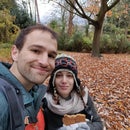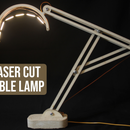Introduction: No-Knead Festive Braided Bread (Challa)
Challa is a special bread we eat on Friday nights and on holidays. It's soft and tender, and it's usually slightly sweet. It's the perfect bread for all kinds of soups and gravies. I think a Challa makes a really nice table ornament too, which makes it a perfect gift for when you visit friends & family for dinner. Apparently, Challa bread costs quite a lot, even though it's super easy to make!
I've been making this bread almost every week for a few years now, and I'm finally ready to share my recipe. I made the recipe so that it is as easy as possible, require no special equipment, and comes out perfect every time. If you've never baked with yeast before this is a great recipe to start with!
Hope you make your own and enjoy!
The recipe can be divided into 5 steps:
- Mix everything.
- Let the dough rise for the first time.
- Braid the Challa.
- Let the dough rise for the second time.
- Bake.
It takes about 2 hours from start to finish, but most of the time is just letting the dough rise or baking it.
Some notes about the recipe:
This recipe is different from other Challa recipes. I use less egg, oil and salt and I actually use more water than usual. These changes mean that the yeast have an easier time multiplying and so you need less of them to get a really tender Challa. Using less yeast improves the flavor of the Challa.
I added some more tips on how to modify your Challa at the end of the instructable (you can use those tips to change any other recipe that uses yeast as well).
Step 1: Gather Ingredients
You'll need a kitchen scale. That's the only special equipment for my recipe. I bought one for about 5$ on AliExpress and as far as I can tell, it's pretty accurate.
The ingredients you'll need:
- 480g (16.9 oz) flour.
- 60g (2.1 oz) sugar. (updated on January 2022)
- 12g (0.4 oz) fresh yeast.
- 3-5g (1 tsp) salt.
- 30ml (~30g) oil.
- 1 egg.
- 310-330ml (1.3-1.4 cups). (updated on January 2022)
- Optional (but highly recommended!) - sesame seeds & kosher (coarse-grained) salt.
It's best to stick to these exact amounts the first time you make this bread :)
Step 2: Mix Everything & Let the Dough Rise!
- Place all of the dry ingredients in a bowl and mix them.
- Add all of the liquid ingredients. Use only half the egg - you'll use the other half later on. You can refrigerate it for now.
- Using a a fork or something similar, mix everything well until you get a wet/sticky dough. It should look like shown in the third picture (or in the video). Add more water until you get the right texture (should be about 320-340ml).
- Let it rise at a warm location for about 30-40 minutes. Remember - if it's warm enough for you, it's warm enough for yeast! (and if it's too cold for you then it's too could of yeast!)
- The dough should double its size and you should see a bunch of bubbles forming at the bottom of the bowl (see 4th image)
*Tip - the easiest (& quickest) way to weight everything is to place the bowl on your kitchen scale and zero the weight with it on.
Step 3: Classic Braided Challa
Once the dough have risen for the first time, we can braid it. Cover a flat surface with lots of flour and roll the dough in it.
We're basically going to braid a regular braid. My main tip is that you don't braid the first part of the bread right from the start. After making 3 strands, pinch them together with one hand and begin braiding with the other hand. Try not to make the braid too tight because that would make the dough tear while baking. Once you get to end, push the edges beneath the rest of the braid and start braiding the other side (see pictures). This method leads to a really even braid.
Place the Challa on a baking tray with parchment paper and let the dough rise for another 30-40 minutes at a warm place.
*Tip - the braid I showed here is a mini Challa, I make these along with the larger ones so that I (or my soon-to-be-wife) can taste the bread before serving! You should make one too :)
Step 4: Round Braided Challa
A video is worth a million words, so I made one. But for those who prefer seeing photos & reading:
To braid a round Challa:
- Cut the dough into 4 pieces and roll them into strands of about 40cm (pictures 3-5).
- Lay two strands horizontally. Place them about 3cm away from each other.
- Lay the other two strands perpendicular to the first two (again - about 3 cm apart) (6th image).
- Begin by arranging the strands as warp and weft (7th image, hopefully I used warp and weft in a sentence correctly).
- The ends of the strands should now be arranged in pairs. Cross the two strands while moving the lower strand of to the top (8th image).
- Repeat all around again and again, until you've braided the Challa as much as you can (images 9-12).
- Hide the edges beneath the rest of the dough (13th image).
That's it, place the Challa on a baking tray with parchment paper and let the dough rise for another 30-40 minutes at a warm place.
Step 5: Brush With Egg and Sprinkle With Sesame Seeds
You're almost done!
Once the dough as risen for the second time, brush it with egg. Make sure to cover the bread from all sides.
Sprinkle with sesame seeds and some Kosher salt (coarse-grained salt).
Step 6: Bake
Bake at 190C/375F in turbo mode (fan ON) for about 20 minutes. The bread should look golden like shown in the pictures.
*Tip - many ovens are much cooler near the oven's door, which leads to uneven baking! If this is the case in your oven, just flip the baking tray a few minutes before the bread is done.
Step 7: You're Done!!
It's time for you an your family to sit back and enjoy the bread you made! You might be in some trouble though, since from now on you have to make this every week....
See you soon! :)
Step 8: BONUS - Tips for the Dough Tinkerers
For those of you who like to make changes in recipes, here are some general notes about baking with yeast and what each of the ingredients does.
- Yeast need water and a carbon source (sugar) to multiply. A bit of salt is fine and is actually helpful for the yeast, but the amount of salt yeast like would make for tasteless bread. There are several ways to overcome this. First, you can add the salt after the dough have risen for the first time. I don't really like this method, so I used a different one - I sprinkled Kosher salt on the bread before baking.
- Adding more flour and oil makes the dough is nicer to work with - it's not going to be sticky and you could knead and play with it. Many people think that having "nice" dough makes for tasty bread. But that's far from true - you have to separate the joy of baking and the joy of eating. If you aim for the tastiest bread possible, it is only a matter of chance that the process will be enjoyable too. I mean, I love making Challas, but some people really love kneading so they wouldn't like sticky dough. That's fine, but it's not optimized for the eating part! Oil will make the dough easier to work with, and the final bread more crunchy (for better or worse).
- Sugar will help the yeast thrive, which means shorter rising times and more fluffy bread. That's great! But it also make the bread sweeter - so make sure you like that too.
- Water makes the dough stickier - but helps the yeast grow. If you put in too much water the bread might not hold itself up when rising.
- Eggs help the dough stay up once baked - they basically help the dough solidify in its final state. Using too many eggs will make for crunchier and less tender bread. It will also make your braid tear up. That's why I try to use as little egg as possible.
Hope these tips help! Let me know if you have any questions or thoughts :)




